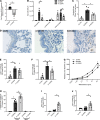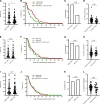miR-122 promotes virus-induced lung disease by targeting SOCS1
- PMID: 33830082
- PMCID: PMC8119205
- DOI: 10.1172/jci.insight.127933
miR-122 promotes virus-induced lung disease by targeting SOCS1
Abstract
Virus-induced respiratory tract infections are a major health burden in childhood, and available treatments are supportive rather than disease modifying. Rhinoviruses (RVs), the cause of approximately 80% of common colds, are detected in nearly half of all infants with bronchiolitis and the majority of children with an asthma exacerbation. Bronchiolitis in early life is a strong risk factor for the development of asthma. Here, we found that RV infection induced the expression of miRNA 122 (miR-122) in mouse lungs and in human airway epithelial cells. In vivo inhibition specifically in the lung reduced neutrophilic inflammation and CXCL2 expression, boosted innate IFN responses, and ameliorated airway hyperreactivity in the absence and in the presence of allergic lung inflammation. Inhibition of miR-122 in the lung increased the levels of suppressor of cytokine signaling 1 (SOCS1), which is an in vitro-validated target of miR-122. Importantly, gene silencing of SOCS1 in vivo completely reversed the protective effects of miR-122 inhibition on RV-induced lung disease. Higher miR-122 expression in nasopharyngeal aspirates was associated with a longer time on oxygen therapy and a higher rate of treatment failure in 87 infants hospitalized with moderately severe bronchiolitis. These results suggest that miR-122 promotes RV-induced lung disease via suppression of its target SOCS1 in vivo. Higher miR-122 expression was associated with worse clinical outcomes, highlighting the potential use of anti-miR-122 oligonucleotides, successfully trialed for treatment of hepatitis C, as potential therapeutics for RV-induced bronchiolitis and asthma exacerbations.
Keywords: Asthma; Inflammation; Molecular biology; Virology.
Conflict of interest statement
Figures





Similar articles
-
Dual role of the miR-146 family in rhinovirus-induced airway inflammation and allergic asthma exacerbation.Clin Transl Med. 2021 Jun;11(6):e427. doi: 10.1002/ctm2.427. Clin Transl Med. 2021. PMID: 34185416 Free PMC article.
-
Increased nuclear suppressor of cytokine signaling 1 in asthmatic bronchial epithelium suppresses rhinovirus induction of innate interferons.J Allergy Clin Immunol. 2015 Jul;136(1):177-188.e11. doi: 10.1016/j.jaci.2014.11.039. Epub 2015 Jan 25. J Allergy Clin Immunol. 2015. PMID: 25630941 Free PMC article.
-
MicroRNA-30a-5p silencing polarizes macrophages toward M2 phenotype to alleviate cardiac injury following viral myocarditis by targeting SOCS1.Am J Physiol Heart Circ Physiol. 2021 Apr 1;320(4):H1348-H1360. doi: 10.1152/ajpheart.00431.2020. Epub 2021 Jan 8. Am J Physiol Heart Circ Physiol. 2021. PMID: 33416455
-
Rhinovirus and the lower respiratory tract.Rev Med Virol. 2004 Jan-Feb;14(1):17-31. doi: 10.1002/rmv.406. Rev Med Virol. 2004. PMID: 14716689 Free PMC article. Review.
-
Rhinoviruses and Their Receptors: Implications for Allergic Disease.Curr Allergy Asthma Rep. 2016 Apr;16(4):30. doi: 10.1007/s11882-016-0608-7. Curr Allergy Asthma Rep. 2016. PMID: 26960297 Free PMC article. Review.
Cited by
-
Circulating miRNA expression in extracellular vesicles is associated with specific injuries after multiple trauma and surgical invasiveness.Front Immunol. 2023 Oct 23;14:1273612. doi: 10.3389/fimmu.2023.1273612. eCollection 2023. Front Immunol. 2023. PMID: 37936707 Free PMC article.
-
Association of cardiometabolic microRNAs with COVID-19 severity and mortality.Cardiovasc Res. 2022 Jan 29;118(2):461-474. doi: 10.1093/cvr/cvab338. Cardiovasc Res. 2022. PMID: 34755842 Free PMC article.
-
Host combats porcine reproductive and respiratory syndrome virus infection at non-coding RNAs level.Virulence. 2024 Dec;15(1):2416551. doi: 10.1080/21505594.2024.2416551. Epub 2024 Oct 18. Virulence. 2024. PMID: 39403796 Free PMC article. Review.
-
miRNAs as Modern Biomarkers in Asthma Therapy.Int J Mol Sci. 2023 Jul 15;24(14):11499. doi: 10.3390/ijms241411499. Int J Mol Sci. 2023. PMID: 37511254 Free PMC article. Review.
-
SARS-CoV-2-associated organs failure and inflammation: a focus on the role of cellular and viral microRNAs.Virol J. 2023 Aug 9;20(1):179. doi: 10.1186/s12985-023-02152-6. Virol J. 2023. PMID: 37559103 Free PMC article. Review.
References
Publication types
MeSH terms
Substances
LinkOut - more resources
Full Text Sources
Other Literature Sources
Medical

